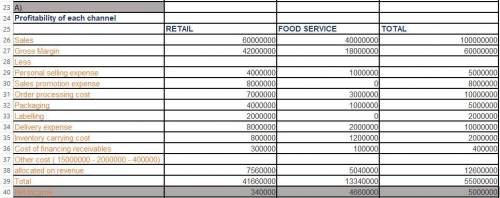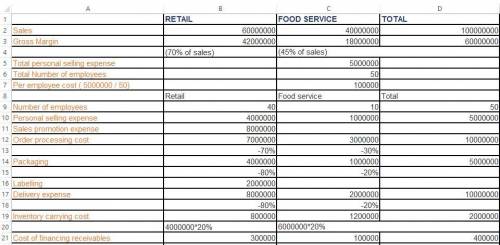
Business, 28.02.2020 20:27 carafaith02
The Cooper Processing Company (CPC) is a manufacturer, or processor, of food products. Located in Lansing, Michigan, the company provides a national market with processed and packaged meat items, such as hot dogs, bologna, and sausage. Due to increased costs in marketing and logistics, CPC hired you as an expert to analyze costs and investments. After analysis, make recommendations to management. The company sells its products through two separate channels of distribution. Each is treated as a separate profit center with full financial responsibility for income statement and balance sheet. The first channel is associated with retail grocery stores and supermarkets. The second channel is associated with foodservice wholesalers who, in turn, sell to restaurants and other foodservice establishments. According to the company’s accounting records, the retail segment accounts for 60% of sales, and foodservice for 40%. The cost accountant believes that both channels are profitable. He says that the company achieves an overall average gross margin of 60% on its sales. In its most recent fiscal year, the company achieved sales of $100,000,000.The cost accountant also provides the following total costs for various marketing and logistics activities at CPC:•Personal Selling $5,000,000•Sales Promotions $8,000,000•Order processing $10,000,000•Packaging $5,000,000•Labeling $2,000,000•Delivery $10,000,000Total Marketing & Logistics costs $40,000,000The total of all other expenses at CPC is $15,000,000.The company’s cost accountant had previously allocated all expenses and investments to the channels based on the percentage of sales volume and has used the overall company average of 60% gross margin to determine the profitability of each channel of distribution. You, being much wiser than the company cost accountant, decide to do a little further analysis. The first thing you discover is that, due to differences in product mix sold in each channel, gross margins actually are different in each. You find that the gross margin in the retail channel is 70%; in the foodservice channel it is 45%.Next, you find that all of the salespeople are paid a straight salary, and all receive exactly the same amount of salary. However, you find that of the 50 sales people employed by CPC, 40 of them are devoted to the retail channel, 10 of them are devoted to the foodservice channel. Since there are no sales managers and each salesperson pays for selling expenses out of their salary, this accounts for all of the personal selling expense. You learn that all sales promotions were conducted in the retail channel. Next, you discover that there is a great difference in the number of orders placed by customers in each channel and the deliveries to each channel. You find that the retail channel accounts for 70% of the orders placed and 80% of the delivery expense. The foodservice channel accounts for 30%of the orders placed and 20% of the delivery expense. Your activity-based approach suggests that this is a reasonable way to trace the costs directly to each segment. Next you learn that packaging differs for each channel. You discover that retail accounts for 80% of the packaging cost, foodservice for 20%. (Don’t worry about how you discovered this).Next, you discover that only the retail channel requires "labeling". The company has a machine which applies these labels. The labeling expense of $2,000,000 includes materials, labor, and depreciation of the machine. The machine has an asset value of $10,000,000.Next, you find that the company has inventory of $10,000,000 (this has also been the average amount of inventory held by the company during the year). You learn that the inventory is specialized by channel. For the retail channel, the inventory is $4,000,000. For the foodservice channel the inventory is $6,000,000. Inventory carrying costs for the firm are 20%.Finally, you learn that the different channels have different terms of sale. Accounts receivable for the retail channel are (and have averaged) $3,000,000. Foodservice accounts receivable are (and have averaged) $1,000,000. You found that the cost of financing accounts receivable is 10%.As hard as you have tried, you cannot find a reasonable basis to trace any other costs or assets directly to the channel segments.1.How "profitable" is each channel?2.What is the ROA of each channel?3.Any recommendations?

Answers: 3


Another question on Business

Business, 22.06.2019 03:10
Transactions that affect earnings do not necessarily affect cash. identify the effect, if any, that each of the following transactions would have upon cash and net income. the first transaction has been completed as an example. (if an amount reduces the account balance then enter with negative sign preceding the number e.g. -15,000 or parentheses e.g. (15, cash net income (a) purchased $120 of supplies for cash. –$120 $0 (b) recorded an adjustment to record use of $35 of the above supplies. (c) made sales of $1,370, all on account. (d) received $700 from customers in payment of their accounts. (e) purchased equipment for cash, $2,450. (f) recorded depreciation of building for period used, $740. click if you would like to show work for this question: open show work
Answers: 3

Business, 22.06.2019 14:30
The face of a company is often that of the lowest paid employees who meet the customers. select one: true false
Answers: 1

Business, 22.06.2019 20:20
Levine inc., which produces a single product, has prepared the following standard cost sheet for one unit of the product. direct materials (9 pounds at $1.80 per pound) $16.20 direct labor (6 hours at $14.00 per hour) $84.00 during the month of april, the company manufactures 270 units and incurs the following actual costs. direct materials purchased and used (2,500 pounds) $5,000 direct labor (1,660 hours) $22,908 compute the total, price, and quantity variances for materials and labor.
Answers: 2

Business, 22.06.2019 20:40
If the ceo of a large, diversified, firm were filling out a fitness report on a division manager (i.e., "grading" the manager), which of the following situations would be likely to cause the manager to receive a better grade? in all cases, assume that other things are held constant.a. the division's basic earning power ratio is above the average of other firms in its industry.b. the division's total assets turnover ratio is below the average for other firms in its industry.c. the division's debt ratio is above the average for other firms in the industry.d. the division's inventory turnover is 6, whereas the average for its competitors is 8.e. the division's dso (days' sales outstanding) is 40, whereas the average for its competitors is 30.
Answers: 1
You know the right answer?
The Cooper Processing Company (CPC) is a manufacturer, or processor, of food products. Located in La...
Questions



Mathematics, 23.02.2021 15:50

Physics, 23.02.2021 15:50

Mathematics, 23.02.2021 15:50

Chemistry, 23.02.2021 15:50

English, 23.02.2021 15:50

Mathematics, 23.02.2021 15:50

Biology, 23.02.2021 15:50


Biology, 23.02.2021 15:50


Mathematics, 23.02.2021 15:50

Health, 23.02.2021 15:50


Biology, 23.02.2021 15:50

Biology, 23.02.2021 15:50

Social Studies, 23.02.2021 15:50

Mathematics, 23.02.2021 15:50

 = 2.00%
= 2.00%




